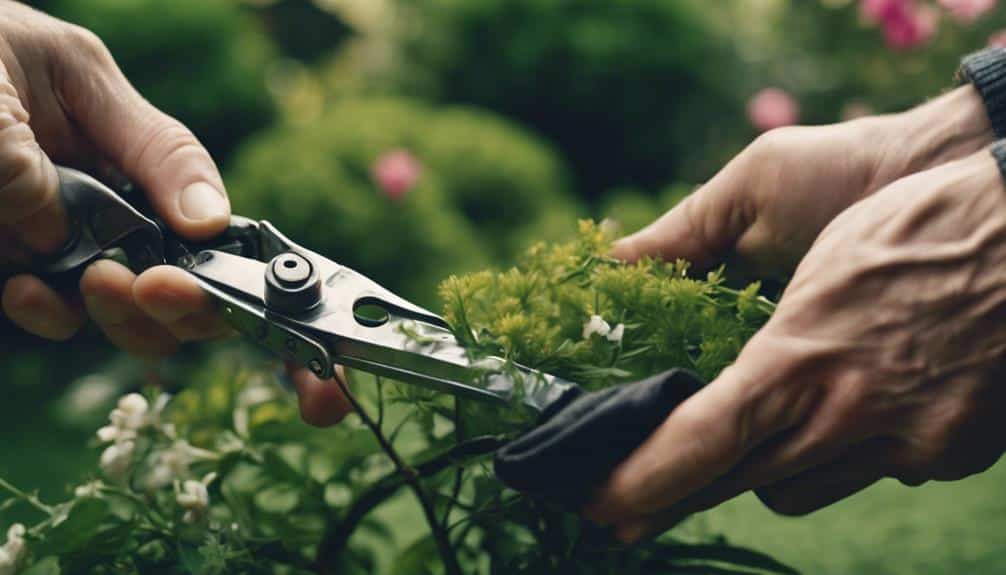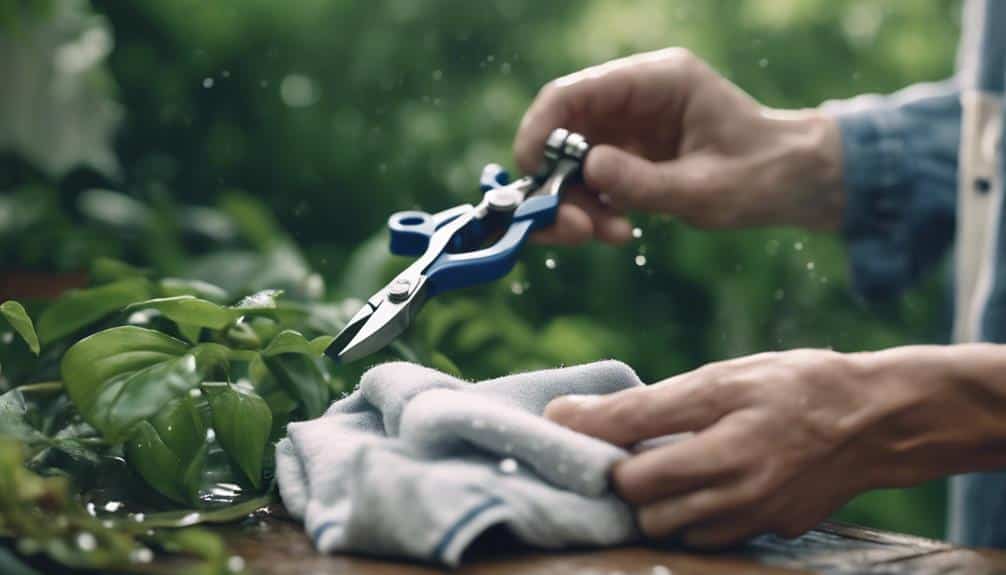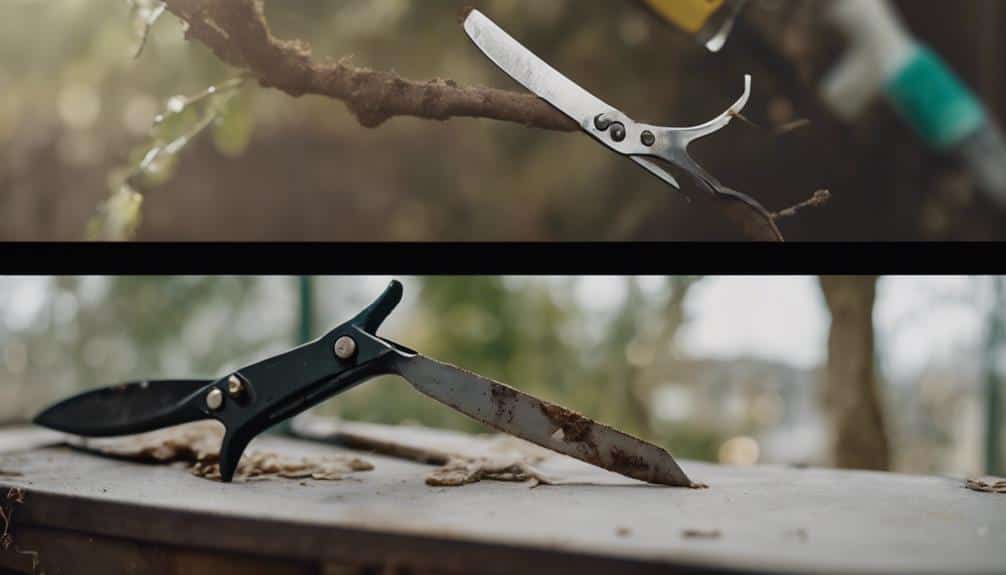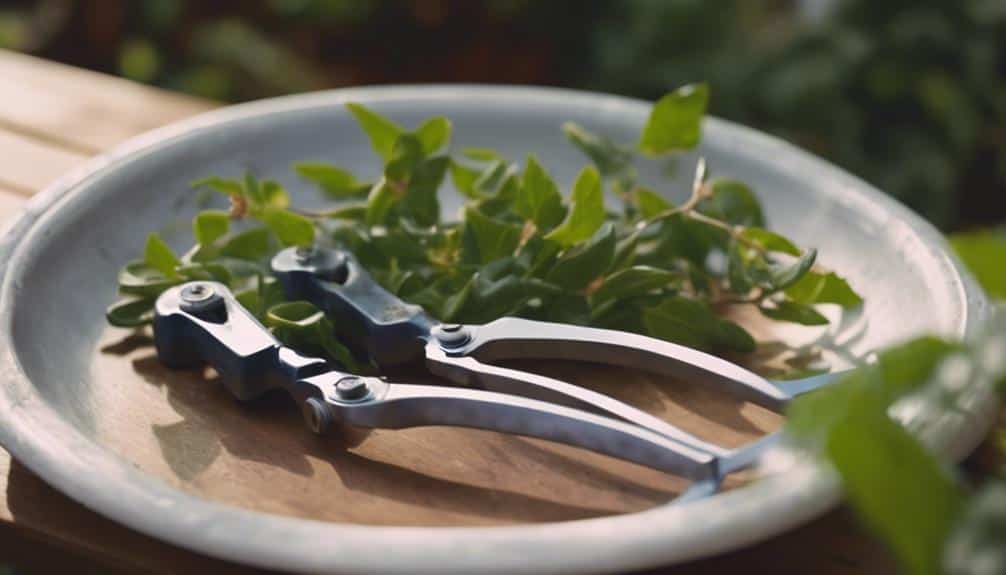How to Sterilize Pruning Shears Between Cuts
When you use pruning shears, it's important to clean them between cuts to stop diseases from spreading. You can clean them with rubbing alcohol, hand sanitizers, or special liquids. Household items like Lysol, Pine-Sol, or Listerine can also work for a quick clean. Remember to clean your pruning shears regularly, ideally after each use, and keep them in a dry place. By doing this, you'll keep your pruning shears free from germs and your plants healthy. Learn more about caring for your pruning shears and keeping your garden thriving.
TLDR
- After each time you cut a plant, clean your pruning shears to stop diseases from spreading. You can use rubbing alcohol or household disinfectants.
- Soak your pruning shears in a mixture of 1 part bleach and 9 parts water for at least 10 minutes to kill germs well.
- To sterilize your pruning shears, you can use alcohol-based solutions like ethanol or isopropyl alcohol, which are effective and easy to find.
- Remember to sterilize your pruning shears every time you move to a new plant to prevent spreading harmful germs and diseases.
- Keeping your pruning shears clean and sterilized is important to prevent diseases and keep your plants healthy.
Choosing the Right Disinfectant

When you need to clean your pruning shears, it's important to choose the right disinfectant to kill germs and prevent plant diseases from spreading. You should clean your tools often while pruning to keep them free from harmful bacteria. You can use rubbing alcohol as an affordable and effective option. Hand sanitizers work well for quick cleaning too. If you prefer a commercial product, there are specialized liquids available. Household items like Lysol, Pine-Sol, and Listerine can also be used to clean your pruning shears effectively without causing any damage.
Preparing Your Pruning Shears
Now that you've picked the right disinfectant, it's time to get your pruning shears ready for cleaning. To make sure they work well and don't spread diseases, focus on keeping them clean, checking the material, and how you store them. Thinking about these things will help you get your pruning shears all set for the best performance.
Cleanliness Is Key
Before you start cutting, make sure to clean your pruning shears well to prevent diseases and bugs from spreading. Get rid of any dirt, sap, or gunk on the blades or handles. It's crucial because dirty shears can easily pass on plant problems from one to another. By keeping your shears clean, you'll lower the risk of infections and protect your plants' health. Remember, cleanliness is crucial for pruning. Having clean shears is necessary for proper sterilization and disinfection. By taking the time to clean them, you can sterilize effectively and stop diseases from spreading.
Tool Material Matters
Once your pruning shears are clean, it's crucial to know what they're made of. Different materials need specific cleaning and sterilizing methods for the best results. The material of your shears is key to keeping them in top shape. If you have stainless steel shears, they're great because they resist rust and can be easily sanitized with alcohol. Carbon steel shears, though, can rust, so make sure to clean and dry them well after use. Aluminum shears are light and strong but might corrode if exposed to strong chemicals. Knowing what your shears are made of helps you sterilize them effectively and make them last longer.
Proper Storage Counts
When you're not using your pruning shears, keep them in a dry place like a toolbox or on a hook. This helps prevent moisture from building up and keeps them working well. Storing them properly is important to keep them in good shape. It stops them from getting rusty or damaged, so they stay sharp for trimming your plants. To keep them clean and germ-free, wash them with a bleach solution after each use. This stops any germs from spreading and keeps your plants healthy. Properly cleaning your tools is essential for plant care and disease prevention.
Effective Disinfecting Methods

To keep your pruning shears clean and prevent diseases, disinfect them regularly, ideally after each use. Rubbing alcohol is a great option for sterilizing your tools. You can also use common household products like Lysol, Pine-Sol, or Listerine without harming your tools. This simple step can help stop the spread of plant diseases. By cleaning your tools between cuts, you lower the risk of passing diseases from one plant to another. Remember, proper disinfection is key to keeping plants healthy.
Safe Disinfectant Options
When selecting a safe disinfectant for your pruning shears, you have a few good choices. Alcohol-based solutions work well and are gentle on your tools. Another option is a mix of bleach and water, which is effective for cleaning.
Alcohol-Based Solutions
You can use alcohol-based solutions like ethanol or isopropyl alcohol to clean your pruning shears between cuts. These solutions are easy to find at drugstores or variety stores. You don't need to mix them with anything – just use them as they are. Alcohol is great at killing germs, so your pruning shears will be germ-free. Store the alcohol away from heat to keep it effective. Using alcohol-based solutions is a reliable way to clean your pruning shears and stop diseases from spreading. It's a simple and safe method to keep your tools and plants healthy.
Bleach and Water
If you want a good way to clean your gardening shears, mix a little bit of bleach with water. Use 1 part bleach and 9 parts water. Soak your shears in this mix for at least 10 minutes to kill any germs. This helps stop diseases spreading between plants. After soaking, rinse the shears with clean water to prevent damage. Gardeners often use bleach and water to clean their shears because it works well. This method keeps your tools germ-free and your plants healthy.
When to Sterilize Pruning Shears

After each time you cut a plant, make sure to clean your pruning shears. This helps stop diseases from spreading between plants. It's super important to sterilize your pruning shears every time you switch plants. This stops harmful germs from moving from one plant to another through the tools. If your plants are sick, clean your pruning shears after every use to prevent spreading the sickness. Keeping your pruning tools clean and germ-free will keep your plants healthy and stop diseases from spreading. Remember, keeping your pruning shears sanitized is crucial to keep pests and diseases away from your garden.
How to Dry Pruning Shears
After you've cleaned your pruning shears, it's important to dry them thoroughly to avoid rust and bacteria. Drying them well is just as crucial as cleaning and disinfecting. Wet shears can grow bacteria and harm the metal, so ensure they are dry. You can either let them air dry or use a clean cloth to remove any leftover moisture. Make sure they are completely dry before storing to prevent fungus. By drying your pruning shears properly, you'll keep them in good shape and avoid rust. This step is essential for maintaining your shears, so take the time to do it properly.
Preventing Microbe Accumulation

To keep your plants healthy, it's important to make sure your pruning shears are free of germs. If you don't clean your pruning tools between cuts, you could spread diseases from one plant to another. To avoid this, regularly disinfect your pruning shears. Just using water to clean them might not be enough. Take extra care to make sure your shears are completely germ-free. By doing this, you'll lower the risk of spreading harmful germs, keeping your plants safe and healthy.
Maintaining Sharp Tools
It's important to sharpen your pruning shears regularly to keep them efficient and prevent harming your plants. Dull blades can hold germs, making it easier to spread diseases. By keeping your shears sharp, you'll make cleaner cuts that heal faster and put less stress on plants. Having sharp tools is crucial for accurate and effective pruning, which is vital for your plants' health. Remember, keeping your tools sharp helps stop infections from spreading. In addition to sterilizing your shears, sharpening them regularly is a must to clean and disinfect your garden tools. This way, you'll ensure your pruning shears stay efficient and safe to use, lowering the risk of spreading diseases.
Best Practices for Sanitizing

When trimming many plants, make sure to clean your shears between cuts to stop diseases from spreading. Use alcohol-based sanitizer, like isopropyl alcohol, to do this right. Soak a cloth in the sanitizer, wipe your shears, and let them dry. Don't use bleach—it can harm your tools. Keep your shears clean to keep them working well. Following these steps will help prevent plant diseases and maintain a healthy garden.
Conclusion
Now you know how to clean your pruning shears between cuts properly. By picking the right cleaner, preparing your shears, and using good cleaning methods, you'll stop plant diseases from spreading. Remember to dry your shears well and keep them sharp for the best results. By doing these steps, you'll keep your shears clean, your plants healthy, and your garden thriving.






